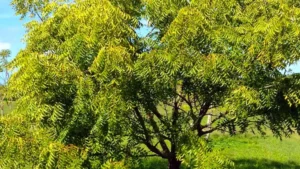Willow Oak Tree
- June 9, 2023
- 1 comment

Common Name and Botanical Name
This spectacular tree is commonly known as the Willow Oak, a nod to its slender, willow-like leaves. The botanical name for the Willow Oak is “Quercus phellos”, setting it firmly within the oak family, or Quercus genus.
Interesting Facts

The Willow Oak, distinctively characterized within the oak family, bears unique foliage that remarkably sets it apart from its relatives. This divergence is particularly evident in the elongated, narrow leaves it possesses, diverging from the more familiar broad-leaf morphology typically associated with oaks. Instead, the Willow Oak’s leaves bear a striking resemblance to those of a willow tree, bringing a refreshing change in the typical perception of oak foliage. This trait creates an intriguing blend of characteristics that combines the steadfast resilience and grandeur of an oak with the delicate elegance of a willow, forming a truly unique hybrid of botanical beauty in the Willow Oak.
Family and Plant Type
The Willow Oak belongs to the Fagaceae family and is a deciduous tree renowned for its fast growth and grand stature.


Hardiness Zones
Hardy and robust, the Willow Oak thrives in USDA hardiness zones 5 through 9.
Mature Size and Growth Rate
A fully-grown Willow Oak is a majestic spectacle, often soaring to lofty heights of 60 to 75 feet, and spreading its robust branches approximately 40 to 60 feet wide, creating a formidable presence in any landscape. Not only is it striking in stature, but its speed of growth is equally remarkable. Known for its swift development, the Willow Oak showcases an astounding capacity to stretch skywards, adding 2 feet or more to its height each year under optimal conditions. This rapid growth, paired with its towering size, casts the Willow Oak as a dynamic marvel within the plant kingdom, representing a potent fusion of sheer scale and extraordinary growth speed.


Soil and Sun Preference
The Willow Oak is a fairly adaptable tree, tolerating a range of soil types, from sandy to clay soils, as long as they are well-drained. It thrives best in full sun but can tolerate partial shade.
Wildlife Value
Willow Oaks is a boon for wildlife, offering valuable habitat and food. Their acorns are a favorite among birds, deer, squirrels, and other small mammals.


Pruning and Propagating
Pruning, usually to remove lower branches as the tree grows, should be done in late winter. Propagation is typically achieved through planting the acorns.
Benefits and Disadvantage
The Willow Oak’s fast growth and impressive size make it an excellent shade or street tree. However, its large size might not be suitable for smaller yards, and it’s susceptible to oak wilt and other diseases.


Attributes
The Willow Oak stands tall with a strong, straight trunk, a rounded crown, and a profusion of slender, willow-like leaves. Its foliage turns a vibrant yellow or bronze in the fall, adding a burst of color to the landscape.
Care
Willow Oaks require little care once established. Regular watering during dry periods and an occasional check for pests and diseases will help ensure the tree’s health.


Edible or Not
While the acorns of the Willow Oak are a food source for wildlife, they are not typically considered edible for humans.
Common Pests & Diseases
While generally robust, Willow Oaks can be susceptible to oak wilt, anthracnose, cankers, and certain pests like the oak lace bug.


Varieties
While there are numerous oak species, the Willow Oak is a unique variant in itself, and there are no commonly recognized cultivars or varieties.
Habitat Requirements
The Willow Oak thrives in well-drained soils and can often be found in floodplains and near streams in its native habitat.


Fun Facts
Interestingly, the Willow Oak’s acorns mature in a single season and are often sprouted and eaten by wildlife before they even hit the ground!
Frequently Asked Questions :
- What is unique about the Willow Oak?
- The Willow Oak stands out because of its unique elongated, narrow leaves that resemble those of a willow tree, unlike the traditional broad leaves of most oak species.
- How large can a mature Willow Oak grow?
- A mature Willow Oak can reach impressive heights of 60 to 75 feet, with a spread of approximately 40 to 60 feet.
- What is the growth rate of a Willow Oak?
- The Willow Oak is known for its rapid growth. Under optimal conditions, it can add 2 feet or more to its height each year.
- What conditions are optimal for Willow Oak growth?
- Willow Oaks thrive in full sun and prefer slightly acidic, well-drained soil. They also tolerate a range of soil types including clay, loam, and sand.
- Where can I plant a Willow Oak?
- Due to their size and growth rate, Willow Oaks are best suited for large landscapes where they can grow and spread without restriction. They’re commonly used as shade trees and street trees.
- Are Willow Oaks resistant to pests and diseases?
- While generally hardy, Willow Oaks can be susceptible to pests like scale insects and diseases such as oak wilt. Regular monitoring and care can help maintain tree health.
- How long does it take for a Willow Oak to mature?
- Willow Oaks typically reach maturity in about 20 to 30 years, though this can vary based on environmental conditions and care.
- Do Willow Oaks produce acorns?
- Yes, like other oaks, Willow Oaks produce acorns. Their acorns are small and enjoyed by a variety of wildlife.

David Murray
Forestry AuthorI'm David Murry, a forestry equipment specialist with a focus on chainsaw operation. With over 13 years of experience, I've honed my skills in operating and maintaining a wide range of machinery, from chainsaws to log splitters. My passion for the outdoors and commitment to sustainable forestry drive my work, which emphasizes safety, efficiency, and staying updated with industry advancements. Additionally, I'm dedicated to sharing my expertise and promoting environmental awareness within the forestry community.













Nice
Joe Kreacken
June 11, 2023 2:20 pm